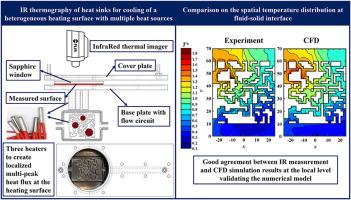多热源异质加热表面液体冷却用优化散热器设计的数值和实验研究
IF 4.9
2区 工程技术
Q1 ENGINEERING, MECHANICAL
International Journal of Thermal Sciences
Pub Date : 2024-11-15
DOI:10.1016/j.ijthermalsci.2024.109540
引用次数: 0
摘要
本文介绍了实验和数值研究,旨在评估和比较用于多热源异质发热表面液体冷却的散热器的性能。对各种散热器原型进行了优化、加工、仪器检测和测试,包括作为基线的均匀直槽(RSC)散热器、优化直槽(OSC)散热器和基于遗传算法的拓扑优化(GATO)散热器。通过引入和安装蓝宝石窗口,采用红外热成像技术测量散热器的近壁流体温度场。获得的详细空间温度分布有助于分析局部的传热特性,CFD 结果与红外测量结果之间的良好一致性为数值模拟模型提供了可靠的验证。结果表明,GATO 散热器的性能始终优于 RSC 和 OSC 散热器,表现出卓越的整体热性能。与其他散热器相比,GATO 散热器具有更强的温度热点消除能力、更高的 Nu 值、更高的 PEC 值和更高的 Le Goff 值。因此,GATO 方法在散热器优化方面的有效性和稳健性得到了证明,凸显了其在解决一般热管理问题方面的巨大潜力。本文章由计算机程序翻译,如有差异,请以英文原文为准。

Numerical and experimental investigation of optimized heat sink designs for liquid cooling of a heterogeneous heating surface with multiple heat sources
This paper presents experimental and numerical studies aimed at evaluating and comparing the performances of heat sinks for liquid cooling of a heterogeneous heat-generating surface with multiple heat sources. Various heat sink prototypes were optimized, machined, instrumented, and tested, including a uniform straight channel (RSC) heat sink as the baseline case, an optimized straight channel (OSC) heat sink, and a genetic algorithm-based topology optimization (GATO) heat sink. Infrared (IR) thermography was employed to measure the near-wall fluid temperature field in the heat sink, facilitated by introduction and installation of a sapphire window. The detailed spatial temperature distribution obtained enabled the analysis of heat transfer characteristics at the local level, with the good agreement between CFD results and IR measurement providing a solid validation of the numerical simulation models.
Following this experimental validation, a systematic numerical study was conducted to evaluate the thermal and hydraulic performances of the three heat sinks under a wide range of operating conditions. Results showed that the GATO heat sink consistently outperforms the RSC and OSC heat sinks, exhibiting superior global thermal performances. This was evidenced by its better temperature hotspot removal capability, higher Nu number, higher PEC number, and higher Le Goff number compared to the other heat sinks. The effectiveness and robustness of the GATO approach for heat sink optimization were thereby proven, highlighting its significant potential in addressing general thermal management issues.
求助全文
通过发布文献求助,成功后即可免费获取论文全文。
去求助
来源期刊

International Journal of Thermal Sciences
工程技术-工程:机械
CiteScore
8.10
自引率
11.10%
发文量
531
审稿时长
55 days
期刊介绍:
The International Journal of Thermal Sciences is a journal devoted to the publication of fundamental studies on the physics of transfer processes in general, with an emphasis on thermal aspects and also applied research on various processes, energy systems and the environment. Articles are published in English and French, and are subject to peer review.
The fundamental subjects considered within the scope of the journal are:
* Heat and relevant mass transfer at all scales (nano, micro and macro) and in all types of material (heterogeneous, composites, biological,...) and fluid flow
* Forced, natural or mixed convection in reactive or non-reactive media
* Single or multi–phase fluid flow with or without phase change
* Near–and far–field radiative heat transfer
* Combined modes of heat transfer in complex systems (for example, plasmas, biological, geological,...)
* Multiscale modelling
The applied research topics include:
* Heat exchangers, heat pipes, cooling processes
* Transport phenomena taking place in industrial processes (chemical, food and agricultural, metallurgical, space and aeronautical, automobile industries)
* Nano–and micro–technology for energy, space, biosystems and devices
* Heat transport analysis in advanced systems
* Impact of energy–related processes on environment, and emerging energy systems
The study of thermophysical properties of materials and fluids, thermal measurement techniques, inverse methods, and the developments of experimental methods are within the scope of the International Journal of Thermal Sciences which also covers the modelling, and numerical methods applied to thermal transfer.
 求助内容:
求助内容: 应助结果提醒方式:
应助结果提醒方式:


